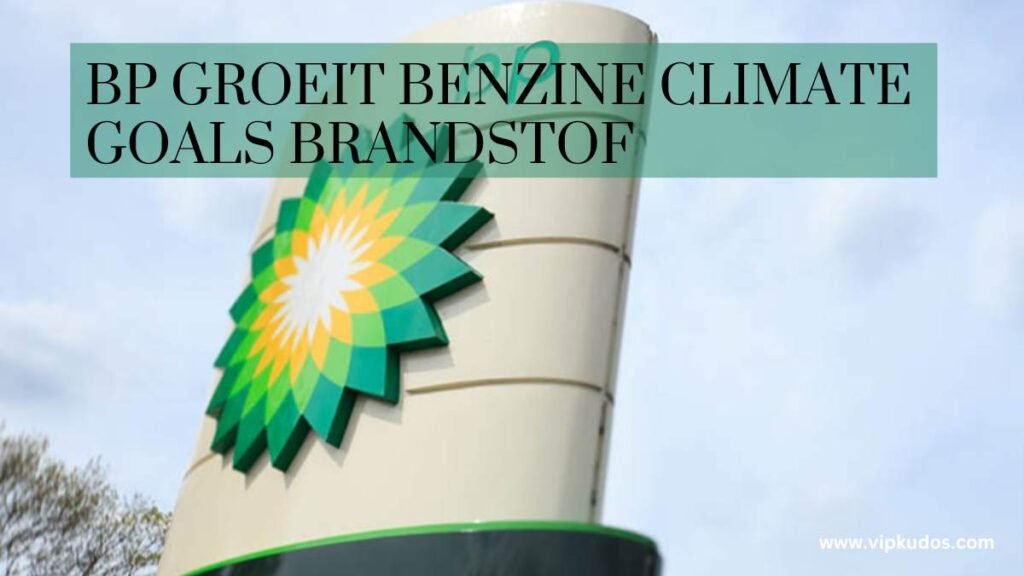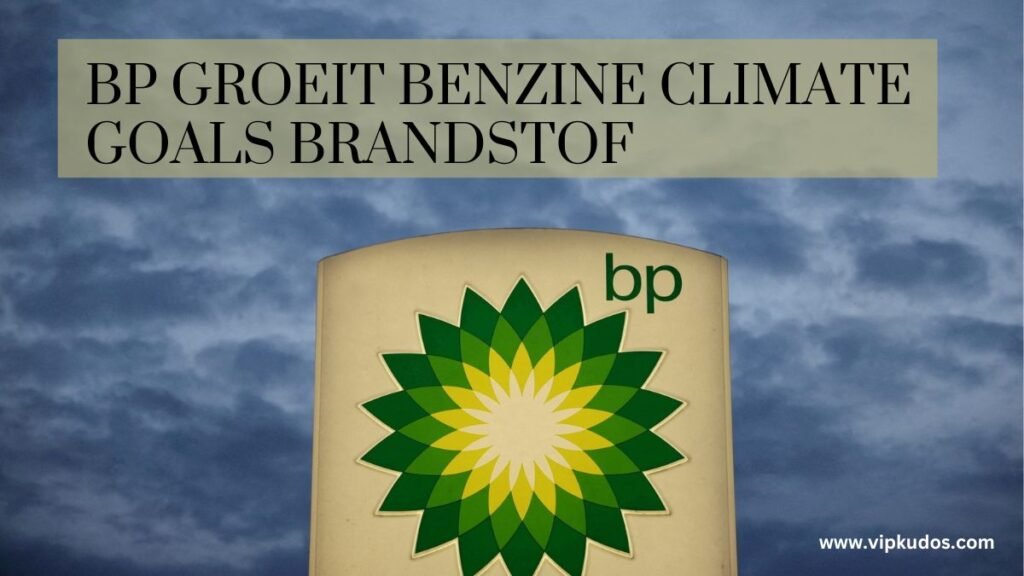Business prosperity has greatly changed through energy supply across the world. One of the companies that has massively changed this sector is BP. This paper aims to provide an overview of BP. It will cover its history, strategies, and main business areas. This article explores bp groeit, benzine, climate goals, brandstof,strategies and challenges. These include expansion, a shift from popular but unhealthy fuels like benzine, and efforts towards exciting, but challenging climate change goals.
Some Facts about BP
BP was a top company in the oil and gas industry. But, recently it has worked to plan for a sustainable future for the environment. Clearly, there is a global trend to reduce the use of nonrenewable resources. So, BP puts much effort into switching from petroleum to renewable energy.
BP Groeit (Growth)
Generally the business growth strategy at BP is to build market share, a goal that has to be pursued with respect to the impact on the environment. The firm has policies of high spending on research and development for better, cleaner energy. They also work to make their operations more efficient. This push for growth and sustainability at its core make BP stand out. It shows BP as a key player in energy transition.
Climate Goals
From the micro-instance, one of the major problems the BP company faces is its inability to meet climate targets. These goals are not mere aims that are aimed at decreasing the emission of gasses but the complete transition of the entire energy sector. BP has declared it will become a Net Zero company by 2050. This means it must greatly cut carbon emissions and use more renewable energy.
The driving forces and challenges in the pursuit of climate goals
It’s an obstacle course that’s especially hard for a company founded in the oil and gas industry. More and more opponents challenge BP and many hurdles stop the company from hitting climate targets. But, BP also wants to expand its operations.
Balancing Growth and Sustainability

The world market now inclines to renewable energy. That’s why BP must consider this to become a competitive, green energy company.
Technological and Economic Hurdles
The move to renewable energy has difficulties. They are on the technological and economic fronts. The difficulties are not easy. Clean energy technology has been a challenging task for mankind due to its complicated nature and high costs involved in the development of such sources of energy.
The key areas for BP’s growth
We must highlight the importance of Benzine for the company. Then, we will analyze the results of its use in more detail. We will also judge how well it works in this area.
Benzine, commonly called gasoline, has been one of the key products. It has shaped the manufacture and global brand of BP for the past few decades. However, due to the increasing concern on the environment and the use of cleaner energy, the importance of benzine is slowly fading.
Environmental Impact
Benzine is quite an element that affects the air. It pollutes the air and adds to greenhouse gas emissions. Benzine is a big part of BP’s products. The company knows it can’t keep using it as it is. BP is keenly aware of the need to find new ways of producing energy that are not as bad for the environment as benzine.
Transition to Alternatives
Benzine pollution has severe effects on the environment. To curb this major problem, BP is researching and expanding production of better fuels to replace benzine. Biofuels, hydrogen, and electric energy solutions are some of the existing renewable power systems. The goal is to build a picture of the fuel sources. They will supply the power the world needs without harming the earth.
The paper aims at presenting Brandstof
Brandstof is the Dutch word for fuel, and one with which BP is seeking to be future-proof as it feels the pressure of global consciousness. This involves not only the conventional oil and gas but also the new, cleaner breeds at par with BP’s challenges in relation to climate change.
Developing Sustainable Fuels
BP is one of the leading companies and they invest in research and development of new fuels. These fuels will, in the long run, cut harmful emissions in transportation and other sectors. Energies for Transport: BP looks to diversify its products to help move towards a low-carbon economy. It plans to invest in advanced biofuels and hydrogen fuel cells.
Enhancing Energy Efficiency
BP improved key strategies to achieve its goals, including enhancing energy efficiency. This involves cutting waste and using the latest tech to work better. It aims to boost how we make and use energy.
Objectives of Brandstof
This outlook is consistent with BP’s brandstof strategy in terms of its relationship to sustainability goals. These include providing efficient and reliable solutions. They use key skills to lead sustainable development.
To Deliver Efficient Solutions
BP’s main goal is to fight for the opportunities and threats. They are in the link between industry growth and its impact on the environment. As a result, BP works on ideas to implement effective solutions. They will help to decrease pollution rates and make the environment healthier for mankind.
To Provide Dependable Alternatives
Given today’s growing concern on the use of fossil fuels, BP continues to work for dependable sources of energy beyond the conventional fuel. These alternatives come in handy in order to prevent the utilization of inanimate resources in the future.
To Lead Sustainable Development
This work fixes a BP aspiration and they want to start the sustainable development of their activities. They will do this by managing non-renewable resources well and taking on environmental responsibilities. The VW ads led to new technologies. They also set benchmarks for sustainable practices.
BP’s Climate Goals
The emission goals for Honeywell-BP are relevant. They show that the company is guided by climate goals, care for future generations, and environmentalism.
Becoming Carbon Neutral
BP has joined the 60+ major companies and they have increased the ambition of their climate targets. They aim to reach net-zero emissions by 2050. This is a plan to cut carbon dioxide pollution. It covers all the company’s activities and includes participating in carbon credit schemes.
Shifting to Renewable Energy
One of BP’s key operational strategies is the increase of investments into renewable resources of energy. These are the wind energy, solar energy and the bioenergy which will have the ability to bring down the carbon footprint of this company.
The country’s climate initiatives also showed the government’s commitment to the global cause. It did this by actively joining these types of climate initiatives:
Among others, BP actively participates in international climate negotiations and partnership agreements. BP can do these programs to be at the forefront of climate action. They also support the global fight against climate change.
Quality Control Processes
The following is a brief overview of some of BP’s quality control measures that are in place that help to make products meet required standards. These are processes such as doing tests often, doing tests all the time, and using tests from other top organizations.
Embracing Renewable Energy
As already discussed, bp groeit, benzine, climate goals, brandstof, has moved to renewable energy sources. So, it’s important to pay great attention to quality. To fix this, the company is now using new tech and techniques. They will make the renewable energy products better and efficient.
Investment in Renewable Energy
This is in line with sustainability as part of its investment in renewable energy, BP has taken a serious stance.
Investing in Biofuels
Currently, BP is shifting its focus to the use of biofuels owing to the fact that it is more disciplined compared to the traditional fuels. It has also been proved that biofuels can cut greenhouse gas emissions. They also provide a source of energy.
Developing Hydrogen Fuel Cells
Hydrogen fuel cells are viewed as a clean energy technology since they do not emit pollutants when compared to the other energy sources. BP is starting to fund fuel cell research and implementation. They aim to create a low-carbon society.
Carbon Capture and Storage
BP is also committed to spending on carbon capture and storage (CCS) tech. They are making additional economic investments in CCS technology. The operating system can capture up to 90 percent of CO2 from industry and this reduces overall emissions.
Conclusion
One can only observe that the path bp groeit, benzine, climate goals, brandstof, has taken to become a company with sustainable business practices is a clear sign. It shows the firm’s willingness to strive for the future’s environmental goals. The company has growth goals and it aims to create new substitutes and set tough, but feasible, climate objectives. These are the reasons it is aiming for a green future.
The struggle for climate change still poses a big question as the future continues to reveal itself. But, BP has shown how other energy companies can deal with the issue. BP is doing everything right on climate change and sustainability. It is meeting its climate goals, proving the company is leading, not just following, the trend toward a better and responsible future.
Also read About
